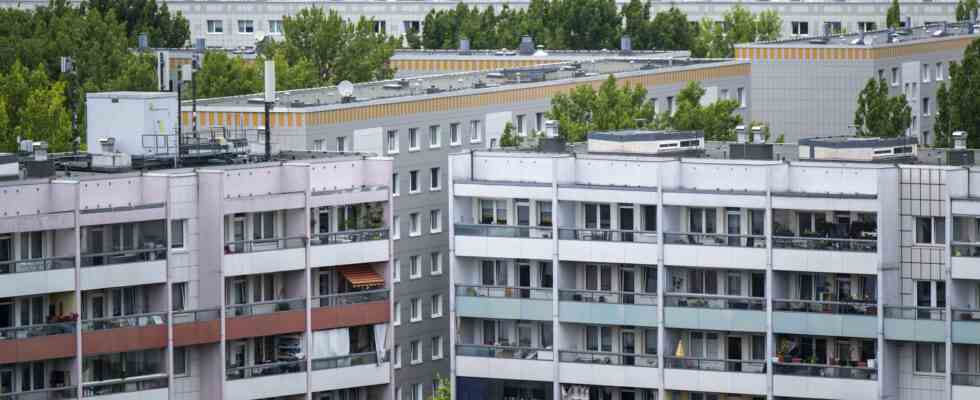Status: 12/12/2022 1:34 p.m
GDR prefabricated buildings were first seen as practical, then as ugly – and now as candidates for demolition. But new life can be breathed into the building materials of the “panels” – and they even look good doing it.
The sports home in Cottbus Kolkwitz is a modern new building. Nothing suggests the old East records. The Cottbus civil engineer Angelika Mettke had 80 concrete parts removed from what she calls a “donor building” in Cottbus: from a prefabricated building that was to be demolished. But Mettke had other plans: As before a surgical intervention, the professor of civil engineering at the BTU Cottbus examined the “patient”, marked the components in question and then had them removed precisely and without damage.
Award-winning concrete recycling
She planned the surgery for two years. The new shell is ready in just four days. The client saved 30,000 euros in costs; the owner of the old prefabricated building part of the disposal costs. Mettke says: 50 percent could be saved by using used concrete slabs – including costs for dismantling, transport and new installation.
Up to 90 percent of the old boards can be reused, says the Cottbus native, but only around 30 percent are used even in reuse projects such as the one for the sports center. “It makes my heart bleed when I see that so many reusable concrete elements are fed into the shredder.” As a “pioneer of concrete recycling”, the Cotbusser was awarded the German Environmental Prize in 2016 for her commitment.
Recycling in times of high prices
For Mettke, recycling has become a professional life project. As early as the 1980s, she examined single-storey GDR multi-purpose halls. The results surprise her: prefabricated buildings that were never actually designed to be dismantled can be dismantled. “And that was the first point on which I said: You can save enormous amounts of resources here. So far, politicians have only focused on energy efficiency, hardly on recycling. That’s not enough.”
Especially since sand and gravel for concrete production meanwhile cost a lot of crushed stone. According to a study by the Federal Institute for Geosciences and Natural Resources, there is no end in sight to the price increases. The prices of the main components would increase by 10 to 15 percent annually. “I think that’s playing into our hands now: Because new building materials are now becoming very expensive and we don’t even know where this will lead, used concrete elements will become more interesting,” says Mettke.
Concrete is a durable building material
The entrepreneur Axel Bretfeld also hopes so. His company Ecosoil Ost built the athletes’ home in Kolkwitz. Ecosoil implements 15 to 20 such projects in eastern Germany every year. It could be much more if it weren’t for the lack of skilled workers and the lack of networking between prefabricated buildings to be demolished and new construction projects. “Normally, the panels are immediately shredded and go to a landfill,” says Bretfeld. Up to 95 percent of the CO2 emissions during cement production could be avoided through reuse. “These two million tons of building rubble every year that are generated by demolition could largely be avoided.”
Ecosoil not only builds new buildings from dismantled prefabricated buildings. The company also preserves them, shrinking multi-storey buildings down to two or three floors, adding a roof terrace or merging apartments. Instead of tearing down the old panels, they will be preserved. That, too, is sustainable – and makes sense, says civil engineer Mettke: “Concrete is a durable building material. It is always assumed that it will be used for 50 years. But concrete does not fall apart after 50 years if it is used properly. Many prefabricated buildings from the 1970s will soon 50 years old and in good condition. In theory, it can even have a service life of up to 120 years.” Concrete slabs could be recycled two to three times in this way.
Hope for EU funding
Contractor Bretfeld works with over 60 housing cooperatives in East Germany. “But they need support in their approval processes. They have a lot of ideas and are left to their own devices.” Many would not have the strength and vision to take care of recycling. “And we as a company are not in a position to manage this logistics either. The money that can be saved: This is only possible if the transport routes are well organized and the panels can be stored cleanly temporarily. The client who decides to do this , is more of an idealist than a thrifty fox, since the savings effect is not that great at the moment.”
Bretfeld wants help from politicians on approval issues. The complex building law does not make it easy to get a building acceptance with used building materials. BTU professor Mettke is trying to develop quality labels as part of the EU-wide “ReCreate” project. She works with experts from Sweden, Finland, the Netherlands and Croatia on prototypes for youth homes. A digital platform is also to be created in order to network demolition builders with new build builders – so that the old, still good prefabricated buildings do not have to end up on the landfill, but get a second life.

